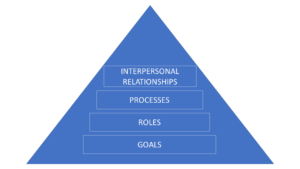What are the elements of an effective team?
Richard Beckhard introduced the GRPI model in 1972 to describe the elements of an effective team.
If you are a leader who wants to build high-performance teams or improve the productivity and efficiency of your existing team, this is a framework to use.
The GRPI model stands for:
- Goals
- Roles
- Processes
- Interpersonal relationships
These elements are hierarchical and determine the effectiveness of a team. The GRPI model can be represented as a pyramid with goals as the basis. Goals are the most important aspect of team effectiveness and performance.

Goals
What’s the purpose of your team?
What’s the expected outcome?
What are the individual goals of each team member?
Defining clear goals is the basis of teamwork. Goals provide the direction and purpose for a team. Goals affect people’s motivation, performance, and relationships.
For instance, Tichy (2007) discovered that 80% of team conflicts were caused by unclear goals.
Team members have to understand, accept, and commit to achieve common objectives.
How do you define clear goals?
Use the SMART framework. Goals should be specific, measurable, action-oriented (with an action plan), realistic, and time-bound.
For example, your sales team’s goal is to increase the revenue by 20% by December 31, 2024. To achieve this, each salesperson will make 50 cold calls per day from tomorrow to the end of December and propose the most expensive product to any prospect first.
Roles
What are the different roles?
Who does what?
Who is responsible for something?
The definition of roles, tasks, and responsibilities constitutes the structure of a team.
Each team member needs to know who is doing what, who is responsible for something, and what are the limits of anybody.
A clear definition of roles and positions is fundamental to working efficiently in a team. Some common tools to define clear roles are organizational charts and job descriptions.
Processes
How are different tasks executed?
What procedures must be implemented?
What methods must be used?
Processes and procedures are agreed guidelines and methods to perform tasks. Shared processes help team members align their activities and work in a methodical way. They are also beneficial for managers who need to assess individual and team performance. Defining team processes enhances team efficiency.
Interpersonal relationships
What’s the general atmosphere in the team?
How cooperative are team members?
What’s the level of trust?
Team members need to interact and cooperate to achieve common goals. Sometimes, we undervalue the relevance of soft skills: wrong words or negative behaviors can result in the loss of talented professionals or clients. Leaders influence communication and relationship dynamics. They can either promote cooperation or conflict.
Cooperation and effective communication are especially critical in complex or critical activities to be performed in a team.
Summary
Effective teams which are productive and efficient should have clear goals, clear roles, clear processes, and positive interpersonal relationships.
Without these elements, teams may cause your company to waste time and money, have conflicts, lose clients, and suffer a bad reputation.
If you want to build a team or improve your existing one, start by defining goals, then roles and processes, and finally, foster open communication and cooperation.
Do you want to improve teamwork in your company?
As a business and organizational psychologist with over 14 years of experience building and improving teams, I can provide you with customized consulting, training, and coaching.
Let’s make your team effective, productive, and efficient. Contact me.
Andrea Miriello
Business and organizational psychologist
Consulting, coaching, and training

